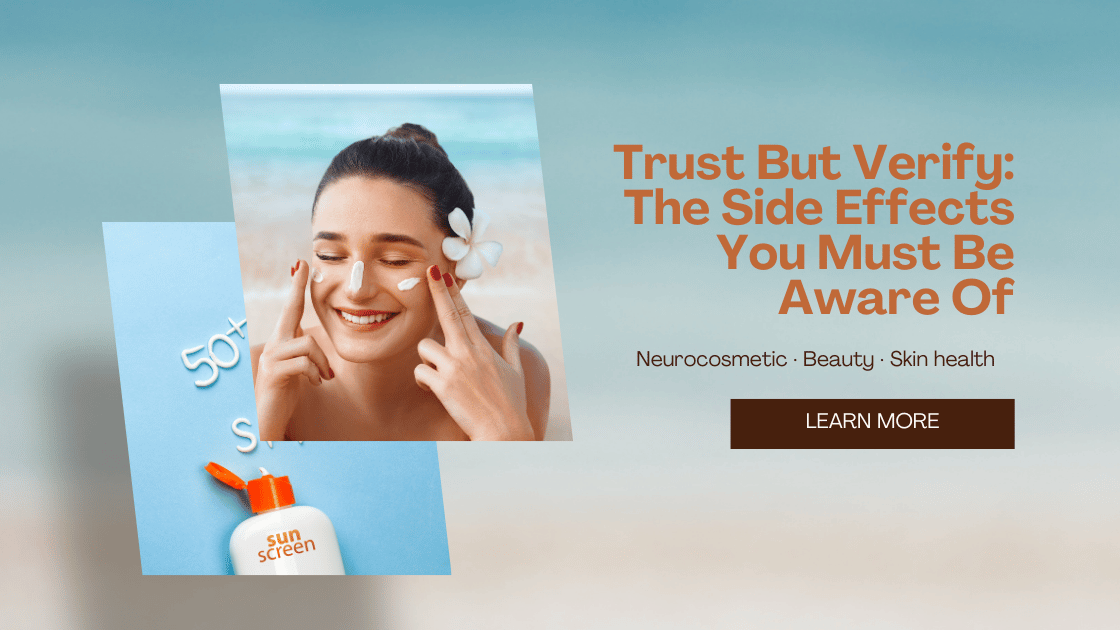In our quest for flawless skin and protection from harmful UV rays, sunscreen has become an indispensable part of our daily routines. However, recent studies suggest that while sunscreens are essential, they are not without potential side effects. This blog delves into the findings of a comprehensive literature review to shed light on the side effects of sunscreen and guide consumers towards safer use.

The Growing Trend of Sunscreen Use
Sunscreen use has surged globally as awareness of the dangers posed by the sun's ultraviolet (UV) rays increases. UV radiation can lead to skin conditions such as sunburn, premature aging, and even skin cancer. Sunscreens, with their ability to absorb, reflect, and scatter UV light, have become our frontline defense against these risks. However, it's crucial to understand the potential adverse effects associated with their use.
Understanding Sunscreen Ingredients
Sunscreens are formulated with a range of ingredients to shield the skin. These include UV filters, emulsifiers, preservatives, and fragrances. Among these, UV filters are the most critical as they block harmful rays. These filters can be broadly classified into organic (chemical) and inorganic (physical) filters:
- Organic UV Filters: These include substances like oxybenzone, avobenzone, and octinoxate. They absorb UV radiation and convert it into heat, preventing it from penetrating the skin.
- Inorganic UV Filters: These include zinc oxide and titanium dioxide. They reflect and scatter UV radiation, acting as a physical barrier on the skin's surface.
Potential Side Effects
Despite their protective benefits, some sunscreen ingredients have raised health concerns. Here are the key findings from recent research:
- Systemic Absorption: Studies have shown that certain sunscreen ingredients can be absorbed into the bloodstream. For instance, oxybenzone has been found at levels significantly higher than the safety threshold set by regulatory agencies. This raises concerns about potential hormonal disruptions and other health effects.
- Endocrine Disruption: Ingredients like oxybenzone and octinoxate are suspected endocrine disruptors. They can interfere with hormone function, potentially affecting reproductive health and development.
- Allergic Reactions: Chemical UV filters can cause allergic reactions in some individuals. Symptoms may include redness, itching, and skin irritation. Benzophenone-3, in particular, has been linked to allergic contact dermatitis.
- Phototoxic Reactions: Some ingredients may cause phototoxicity, where exposure to sunlight triggers a toxic response. This can result in skin rashes and increased sensitivity to sunlight.
- Environmental Impact: Sunscreen ingredients can also affect marine ecosystems. Chemicals like oxybenzone and octinoxate have been found to contribute to coral bleaching and harm aquatic life.
Evaluating Sunscreen Effectiveness
When choosing a sunscreen, it's essential to consider its effectiveness and safety. The Sun Protection Factor (SPF) measures how well a sunscreen protects against UVB rays, which cause sunburn. Additionally, look for broad-spectrum sunscreens that offer UVA protection, which helps prevent premature aging and skin cancer.
Safer Sunscreen Choices
To minimize risks while enjoying the benefits of sunscreen, consider the following tips:
- Option for Physical Sunscreens: Inorganic filters like zinc oxide and titanium dioxide are generally considered safer as they do not penetrate the skin.
- Check for Allergens: If you have sensitive skin, avoid sunscreens with fragrances and preservatives known to cause allergic reactions.
- Consider Environmental Impact: Choose reef-safe sunscreens free from harmful chemicals like oxybenzone and octinoxate to protect marine life.
- Read Labels Carefully: Pay attention to the ingredient list and choose products with safer, tested ingredients.
Conclusion
Sunscreens remain a crucial tool in protecting our skin from the harmful effects of UV radiation. However, it's essential to use them with an understanding of potential side effects and choose products that offer safe and effective protection. By being informed consumers, we can enjoy the sun responsibly and safeguard our health and the environment.
References
- Literature review on sunscreen
- Geoffrey K, Mwangi AN, Maru SM. Sunscreen products: Rationale for use, formulation development and regulatory considerations. Saudi Pharm J 2019;27:1009-18.
- Sander M, Burbidge T, Beecker J. The efficacy and safety of sunscreen use for the prevention of skin cancer. CMAJ 2020;192
- Fivenson D, Sabzevari N, Qiblawi S, et al. Sunscreens: UV filters to protect us: Part 2-Increasing awareness of UV filters and their potential toxicities to us and our environment. Int J Womens Dermatol 2021;7:45-69.
By staying informed and cautious, we can continue to protect our skin effectively without compromising our health or the environment.

